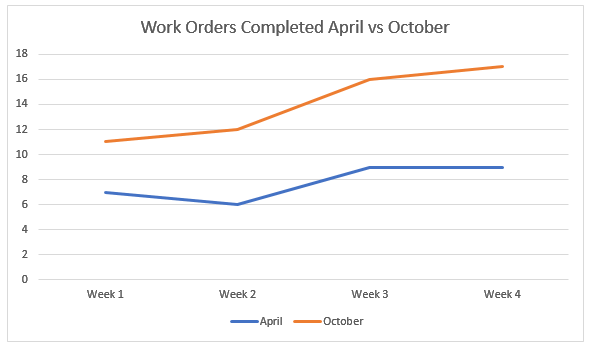 As an Enterprise Maintenance Planner, you manage the backlog, provide a maintenance schedule, liaise with Maintenance and Operations, maintain excellent knowledge of the facility and its equipment, and find ways to optimize productivity. Phew! That’s no small to-do list.
As an Enterprise Maintenance Planner, you manage the backlog, provide a maintenance schedule, liaise with Maintenance and Operations, maintain excellent knowledge of the facility and its equipment, and find ways to optimize productivity. Phew! That’s no small to-do list.
Every day, you’re working hard to:
- Keep the backlog as low as possible
- Keep downtime to a minimum
- Manage an organized working schedule
- Successfully communicate updates to Operations and Maintenance
- Work towards many other tasks and goals too!
But that’s the big picture. On a weekly basis, what are you doing to ensure the right people are kept in the loop, the best possible solutions are devised, and that your organization is learning from its mistakes?
That’s what your report in the weekly Planning and Scheduling meeting should do.
Not sure what to report on? Here are some pointers on how to present the right information during your next meeting:
-
Organize the conversation around past, present, and future.
There’s a common theme among professionals in the field of Enterprise Maintenance Planning: Past, present, and future.
- What happened last week?
- What is happening this week?
- What will happen in the coming weeks?
Using this method can produce measurable improvements. As the saying goes, “the definition of insanity is doing the same thing over and over and expecting different results”. By addressing past successes and failures, it becomes easier to forecast and plan future methods.
To put this method into action, organize your weekly Planning and Scheduling update as such As you know, one of the main responsibilities of the Maintenance Planner is to plan work orders weeks in advance. In the weekly Planning and Scheduling meeting, you should discuss plans for the week so that Operations and Maintenance can agree to the plan and sign off on it. The work order plan should answer the following questions[2]: This is subject to change and should be discussed in each meeting. For example, if the task duration has been consistently shorter for the same type of task, the Maintenance Planner can discuss changing the expected time with the team. These details help the team forecast the cost and time that will be spent on the planned task. Part of the purpose of conducting weekly meetings is to share the status of the backlog and provide an optimized solution. A solution is derived from past successes and work completed on time, the first time. Some of the most common metrics you should measure and report on include:[3] You should consider a strategic sequence in which to discuss the above items; the order will vary based on your organization’s needs and priorities. This information gives a quick and overarching statement regarding the current efficiency of the team. The key to a successful report is to give only the data that is necessary and relevant to the team. Excess data only increases meeting time and drowns team members in too much information that they can’t use or retain. However, having the supporting details available is necessary. A great meeting can fall apart if people aren’t giving these topics the attention they deserve. A recent study by The Telegraph found that the average attention span of an adult is eight seconds[4]. Therefore, keep the meeting highly focused and on point and use visuals, graphics, power point presentations, and charts to make information digestible and interesting. I have found that people tend to be more responsive to graphs and visuals and can digest the information quickly. You can either drone on with this monologue: “For the month of April, the team completed an average of eight maintenance tasks a week without the use of a Maintenance Planner. Since filling the Maintenance Planner position, the team has seen an increase of fourteen maintenance tasks a week for the month of October. Both months saw the same number of tasks in the backlog, thus resulting in a decreased backlog for the month of October.” Or you can show your audience with a chart and a quick summary: According to 3M, inventors of the post-it note, people process visuals 60,000 times faster than text.[5] Charts and graphs are worth your time to create because they can reduce the average meeting time and increase the team’s ability to retain the information. After all, it’s much easier to remember an upward trend than a paragraph of speech. What Does a Successful Planning and Scheduling Meeting Look Like? At the end of the weekly meeting, take a few minutes to evaluate yourself and the meeting, so that you can make improvements for next week. Use these criteria to see if your meeting was a success: As an Enterprise Maintenance Planner, you have a lot on your plate. But part of excelling in your work is keeping the right people in the loop, and reporting on the results of your efforts. The weekly Planning and Scheduling meeting is a great opportunity to achieve this – if you use your time effectively. Use the four tips above to make sure your discussion stays productive and focused. How do you run your weekly Planning and Scheduling meetings? Did we miss any tips? MATT MIDAS Director of Sales, SOLUFY. Matt shares maintenance planning and scheduling wisdom at: https://www.solufy.com/blog/author/matt-midas Matt has been involved in the maintenance and reliability industry for over 30 years. A graduate of the US Merchant Marine Academy, he has served aboard US flag merchant vessels and upon graduation, he was commissioned in the US Navy and served aboard the USS Jesse L Brown, FF1089, where he was responsible for operations, maintenance, engineering, and safety programs. Matt has worked at the Charleston Naval Shipyard where he was qualified as a nuclear engineer in the maintenance, repair and overhaul of S5W and S6G nuclear propulsion plants. He has also worked as a plant operations and maintenance manager where he was responsible for 186 facilities in Washington DC. Matt has helped many customers leverage the data in EAM Systems to support the safe and reliable operations of their critical physical assets. He has also earned an MBA from Loyola College in Maryland [1] http://archive.constantcontact.com/fs031/1102579612852/archive/1109600091514.html [2] https://www.assetivity.com.au/article/maintenance-management/5-tips-for-more-effective-maintenance-planning-and-scheduling.html [3] https://www.lifetime-reliability.com/cms/faqs/maintenance-planning-and-scheduling/faq-maintenance-planning-scheduling-duties/ [4] http://www.telegraph.co.uk/science/2016/03/12/humans-have-shorter-attention-span-than-goldfish-thanks-to-smart/ [5] http://web.archive.org/web/20001014041642/http://www.3m.com:80/meetingnetwork/files/meetingguide_pres.pdf [6] http://www.reliableplant.com/Read/507/meetings-planning-scheduling
Discuss maintenance work orders in-depth.
Cover the maintenance task metrics.
Make maintenance data visual and memorable.



Maintenance planner has one of the tough tasks out there.This article describes perfectly about what to do in a best way possible. https://www.roadtoreliability.com/ provide world class training, coaching and consultancy services at very competitive costs about all these in more simple and perfect way.
Hi Bill,
That is had to say, but I would expect questions on job plans, schedule types, technical writing, etc.
what type of questions do i expect from an interview regarding maintenance planning asistant